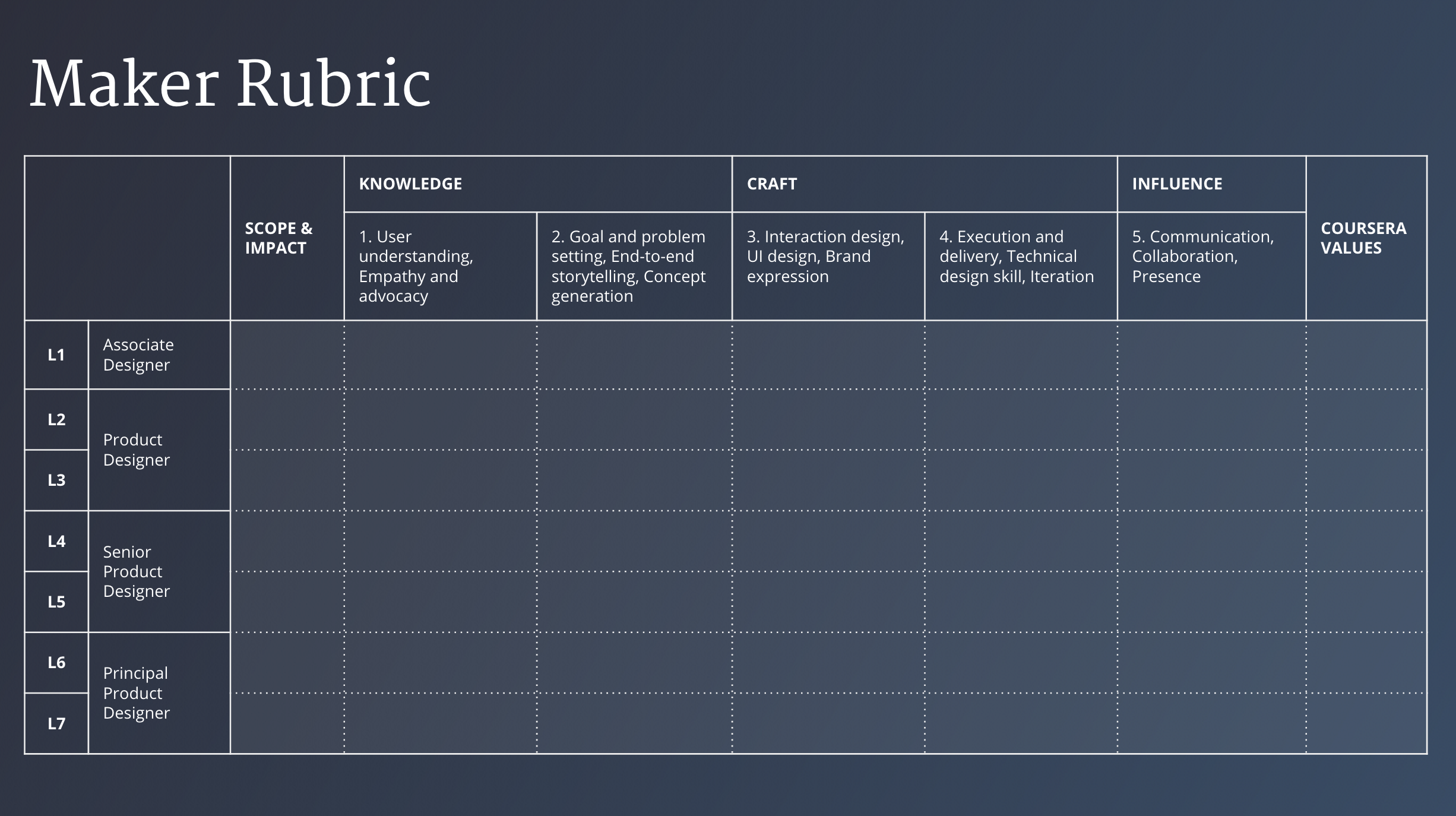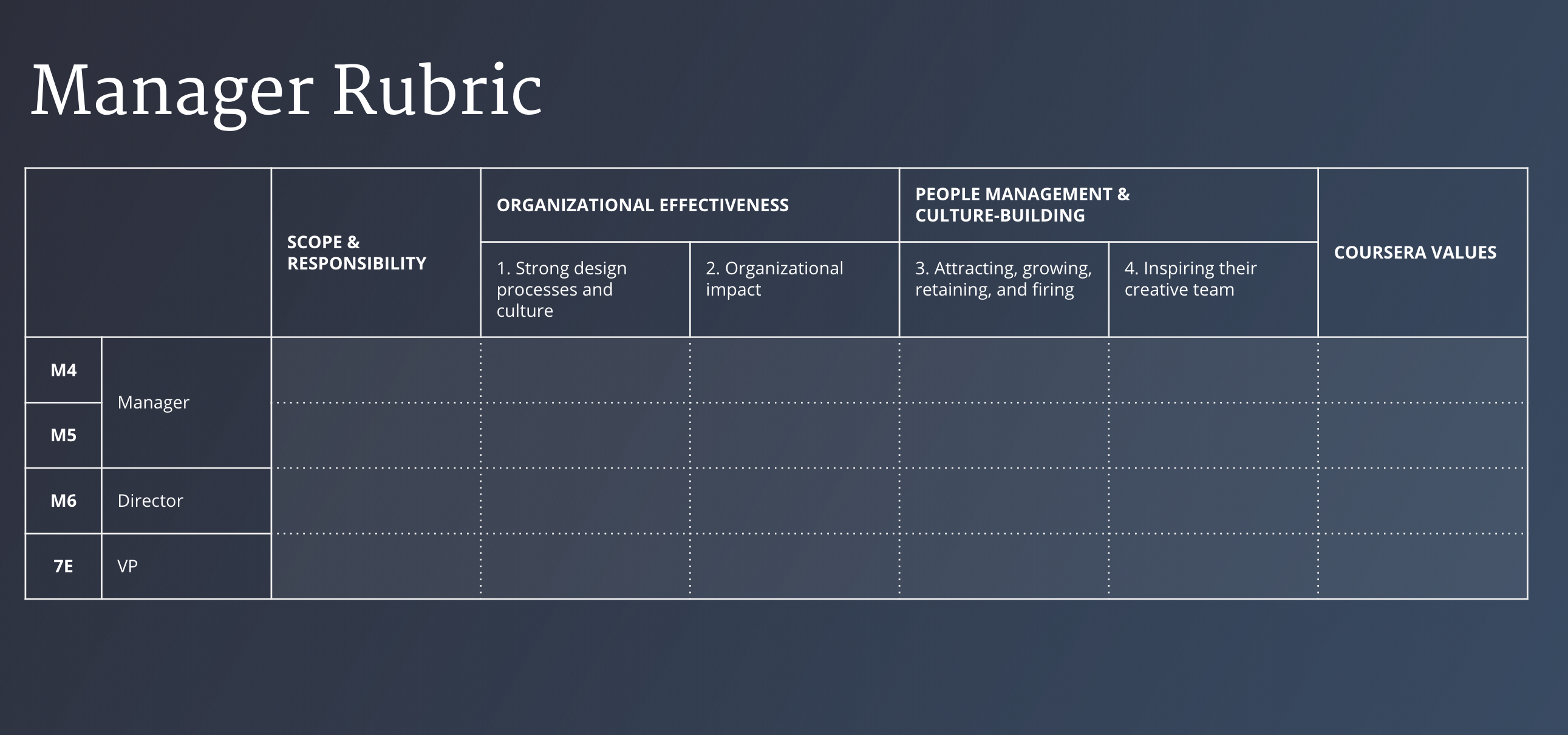A Design Team’s Guide to Leveling
This is the first article in our four-part series on design leadership. Join our email newsletter to stay up to date on the full series and other Designer Fund news.
A design team with an excellent job leveling system has an easier time retaining the designers they worked so hard to hire.
Practically speaking, leveling can be directly tied to career path, job titles, salary bands, and how valued an employee feels. And more broadly, it supports the everyday expression of company values, which provides the intrinsic motivation and purpose necessary for an individual to feel fulfilled by their work.
The main purposes of leveling are to:
- Clarify roles and responsibilities for more efficient collaboration within the design team and among company departments.
- Create an environment of growth where designers are rewarded with a sense of career progress.
- Reflect on company values, clarify which behaviors support them, and measure performance accordingly.
- Perform due diligence about where design candidates fit within a design organization and the broader company, and provide guardrails for just hiring practices and equitable salaries regardless of a candidate’s demographics and negotiation skills.
All companies need to think about leveling as they grow. But unfortunately there are few best practices for how to level effectively, and little information is publicly shared about the topic. As Rhiannon Bell, NerdWallet’s VP of UX & Design, told us, “I don’t think there’s a gold standard in the design industry. People are making it up on their own.”
And perhaps that’s for good reason. An effective leveling, titling, and performance system must be a unique reflection of a company’s values. A one-size-fits-all process simply doesn’t suffice.
We spoke with design leaders from companies like Inkling, GoPro, PlanGrid, Strava, Gusto, Lookout, Coursera, and NerdWallet, and found that their levels look very different. But here are a few common threads to consider if you are a design team leader, startup executive, or HR leader as you chart a leveling (or re-leveling) plan for your company. Thanks to Coursera, we’ve also included a special look into the leveling process and new rubrics of the 5-year-old company.

Make leveling a company-wide effort
The best way to level a design organization is to do it at the same time as the rest of the company, with other teams like product, engineering, and marketing. And if a simultaneous leveling process isn’t possible, make sure to calibrate your levels to the existing levels of other teams. Leveling isn’t done in a vacuum, even if it’s just for your department: be transparent with your team’s level descriptions, get buy-in from stakeholders outside of the design team, and make sure you’re philosophically aligned with the rest of the company.
There are a few practical reasons for this. When levels across departments match one another’s scope of influence on product and people, it clarifies roles, suggests natural counterparts, and brings together employees from different disciplines to take ownership over shared problems and solve them together. It also allows for easier lateral moves: for example, a product manager transitioning to design, or a designer moving to engineering, would have an easier time finding the right role if scope and career paths are aligned.
Companies usually appoint a dedicated central leader from their talent / HR team to spearhead the leveling process for one or more departments. Managers of teams, such as design managers, are involved in creating job levels that fit individual roles. Executives and talent leads sign off on the levels and make sure they’re calibrated across teams. In Coursera’s recent leveling process, they hired a full-time Director of Learning and Development (who previously led Organizational Development at Google) to partner with their head of People Ops and run most of the leveling process. They also hired a compensation consultant to define compensation ranges, who didn’t participate in defining specific levels but was involved in the overall process.

Reassure employees with transparency about the leveling process
If you’re part of a leadership team spearheading a leveling process, take the time to communicate with employees about why you think it’s an important initiative, why now is the right time, how you expect it to influence long-term company performance, and how it will benefit individual designers. This is critical in cases where employees have negative perceptions about leveling or feel anxious about what the impact will be on their career.
Be transparent about your timeline and tactical plans, because you want to avoid blindsiding employees with a conversation about what their “new” level will be going forward. Lay out a timeline for these major milestones, along with more granular tasks that your team will take on during leveling:
- Decide how to structure levels and titles.
- Define what each job level or role looks like.
- Assign specific levels to current employees.
- Share the new job level structure with the company as a whole.
- Have 1-on-1 conversations with individual employees about their new level. [Pro tip: Make sure all 1-on-1 conversations happen within 1-2 weeks after revealing a high-level rubric to the company.]
Share this timeline with the entire company and update them consistently.
For example, Coursera kicked off their recent leveling process with a team meeting in which their leadership introduced the rationale for the upcoming leveling and presented their timeline. As it progressed, they used all hands meetings and emails to communicate “We are here” on the timeline. “Designing that process and being thoughtful about it was very healthy for us. No one was surprised,” reports Minjeong Kim, Design Manager at Coursera, who saw the team grow from one designer (her) to over twenty.

Choose an appropriate number of levels for your company’s size
How many levels should a company have? There’s no right answer, and in the wild you’ll find huge variability in how many levels there are in different organizations.
A small startup with one or two designers may start with just one or two completely informal levels. Another startup may use four levels, such as Junior Designer, Senior Designer, Design Manager, and Design Director. Many later-stage startups we spoke to, like Coursera, have seven levels in their design organization, as does Facebook’s engineering team (as of 2015), while GoPro has 12 to give employees a quicker sense of progress. And Microsoft’s levels are numbered roughly 37 through 80 (at least for software engineers — the reports vary).
But there’s one trend: as a company gets larger, their leveling shows greater resolution. It usually starts simple for the first few years. Several growth-stage startups expressed a desire for simplicity in their leveling to accommodate the ambiguity of shifting roles that come with scaling a team quickly. There’s also the desire for a “flat” decision-making structure: many companies want to empower individuals at all levels of their organization to make autonomous decisions, so they opt for a shorter hierarchy, if any, in the early days.

Write job level descriptions that reflect company values
Leveling is an excellent opportunity to crystallize and celebrate company values. Job descriptions and evaluation rubrics should set expectations for how an employee should impact their product, their team, and the business as a whole, and set the stage for rewarding value-driven behaviors with positive evaluations and promotion.
Companies vary in how specific and prescriptive job descriptions should be. One team we spoke with believes that specific behavioral examples are the most objective measure of behaviors that support company values. With this approach, teams lay out illustrative scenarios to explain the type of activities and attitudes they expect of their employees.
For example, if a company values cross-team collaboration, a specific behavioral example might be: “A senior designer volunteers to help out with another team’s production push over the weekend without being asked.” But if a company values speed of shipping features, job descriptions might be based around quantitative metrics like “Designer ships 2 new features per quarter.” As you can see, job descriptions are unique reflections of a company’s values and can look very different from business to business, even at the same level and in the same industry.
Another team we spoke with expressed concern that very specific job descriptions cause employees to operate within constraints the management team has laid out, limiting the freedom and autonomy within roles that is so important for growth-stage startups. They are exploring an approach where they define core values and expect senior employees to deliver more thoroughly on them, while they leave the day-to-day specifics more open-ended.
Example: Coursera’s Maker & Manager Rubrics
Coursera recently underwent their first official company-wide leveling process and used the following rubric structures as frameworks for their level descriptions.
One of their biggest motivators to do this as a 5-year-old company was to show a clear path to advancement for individual contributors (ICs). Previously, you had to become a manager in order to level up. So they created different rubrics for design Makers (ICs) and design Managers. Research, Product writing, and Design Manager roles each have their own table.
In the rubric below for Makers in product design, there are 7 levels running down the left-hand side. Levels are accompanied by a title, and two levels are sometimes grouped into the same one. Across the top, there are 5 focus areas that Coursera’s design team prioritizes, such as “User understanding, empathy, and advocacy,” organized by theme. There is a special 6th column dedicated to a focus on Coursera values, which are “Betterment, Deep Honesty, Boldness, and Solidarity.”
The team adds specific expectations around roles and responsibilities for each of these focus areas in the boxes dedicated to each level, such as:
- Storytelling: is able to sketch and talk through design using a persona and story arc, based on user mindset, motivation, and key tasks over time.
- Systems thinking: can grasp and and illustrate how details fit into bigger picture for the user and to the product, platform, and company.
- Brand expression: brings Coursera’s brand attributes to life throughout the product experience to inspire learners and partners.
- Influence: Drives groups to consensus for best design solution, with input. Takes ownership of decisions. Is bold! Makes tough decisions or takes smart risks.
The “Scope & Impact” column brings it all together and summarizes the level’s influence. A Level 2 scope might be to carry out projects with guidance from a project lead or manager. A Level 3 designer can take on reasonably defined projects independently, and at Level 4, the designer starts to tackle more ambiguous and complex problems. At Level 5 and beyond, the designer demonstrates influence beyond the immediate project or project team, enhancing the performance and skill level of the entire design team and influencing the whole business.

Research, Product writing, and Design Manager roles each have their own table.
The Manager rubric follows a similar structure with different focus areas to reflect their craft. Managers must be level 4 and up, and have different titles than Makers.
For example, their overarching themes cover “Organizational Effectiveness” and “People Management and Culture Building,” in contrast with the Maker themes of “Knowledge,” “Craft,” and “Influence.” The column dedicated to Coursera Values remains.

Design titles that let employees grow
Job levels are generally kept private between an employee and their managers, while job titles are public. Just as each company has a different approach to job levels, there’s no one right way to assign titles.
Most companies “squash” multiple levels into a smaller number of titles:
Example: 7 levels “squashed” into 3 titles
“Designer” = Levels 1 and 2
“Senior Designer” = Levels 3, 4, and 5
“Principal Designer” or “Design Director” = Levels 6 and 7
Squashing titles keeps external-facing titles simple for people outside the company. It also can give individuals a little room to grow and get promoted within their current title, as well as a little privacy from coworkers about exactly which salary band they are in.
Many companies cited the importance of creating titles and levels that allowed individual contributors (ICs) to advance their careers without becoming managers. One that we spoke with shared a flexible leveling and titling system that easily accommodates for this type of career growth and switching back and forth between focuses. Here’s how it looks:
Example: Pairing titles method
For each discipline (design, for example), pair titles that indicate (1) someone’s scope of influence on the product and (2) their scope of influence on people.
(1) Scope of influence on product
Titles increase in level as an employee’s product scope expands. For example, a junior designer’s scope may be limited to a feature, while increasingly higher levels may work on a feature set, a product area, a product, a product line, multiple product lines, or demonstrate industry-wide influence.
Sample titles for this component might be:
- Junior/associate (roughly 1-2 years of experience, for example)
- Designer (roughly 3-5 years, for example)
- Senior designer
- Principal
- Partner
(2) Scope of influence on team
Titles reflect whether or not they are leading other employees, and if so, how many. Individual contributors don’t manage people, but other employees might lead one team, multiple teams, the entire design organization, or the company.
Sample titles for this component might be:
- IC
- Lead [who manages ICs]
- Manager [who manages Leads]
- Directors [who manages Managers]
- VP [who manages directors]
Result: Paired Titles
Here are some example titles under this system:
- Senior Design Manager: A person who influences 1 product area and manages 1 team.
- Principal Director: A person who multiple managers across all products in one product line.
- Principal Designer: A very senior IC designer who doesn’t manage employees but has industry-wide influence. For example, Susan Kare at Pinterest doesn’t have a management focus, but she is a highly influential figure in design, with decades of iconic work, Museum of Modern Art features, etc.
With this approach, individual contributors have room for just as much career growth as managers, and people can easily move between a focus on individual contributions and management rather than being stuck on a “track.”
HR and payroll startup, Gusto, took a different tack and removed titles altogether. Their job hiring pages advertise for a position in “Product Design,” instead of a title such as “Senior Designer” (although they do distinguish management roles to attract management-focused candidates). They took this approach to uphold their company value of “no egos” and simplify the organization, among other reasons.
They report a positive impact overall, particularly in the recruiting realm where their pipeline has an influx of great candidates who are more aligned with company values. And the slight wording shift from “senior customer care advocate” to “I’m on the care team” reflects the collaborative nature of their team.
There are a few learnings as well. For example, they found that their new approach made their job listings SEO-unfriendly, so their overall application volume has decreased. And since the change, Gusto employees have asked more about their career paths, so the company plans to roll out internal leveling to mark growth milestones.
Finding the right leveling system for your team is core to its long-term health. If done well, it can help you retain your employees, create a rich future for them at your company, facilitate collaboration, and guide hiring decisions. Whichever approach you take, design it thoughtfully, share plans transparently with your organization, and take it as an opportunity to channel your company’s best values into the everyday priorities of your employees.